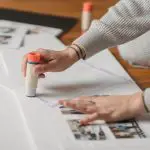Do you have a project that involves gluing paper onto fabric? Maybe you’re creating a collage or adding a design to a shirt. Whatever your project may be, it’s important to know the right techniques for gluing paper to fabric.
With the right materials and steps, you can create a seamless bond between the two materials that will withstand wear and tear.
First, gather all of your materials. You’ll need paper, fabric, scissors, and fabric glue.
Make sure the paper and fabric are clean and dry before starting. You don’t want any dirt or moisture interfering with the glue’s adhesion.
Once you have all of your materials ready, you can prep them for gluing. By following these steps, you can ensure a successful and long-lasting bond between your paper and fabric.
Table of Contents
Gather Materials
You’re gonna need some glue, paper, and fabric to make a masterpiece that will blow everyone away! To start, gather all the materials you’ll need for this project.
Make sure you have a good quality glue that won’t damage the fabric or paper. You can use either a spray adhesive or a liquid glue, but make sure it’s suitable for both materials.
Next, choose the paper and fabric you want to use. You can use any type of paper, from plain white printer paper to decorative scrapbook paper. The fabric can be any type of cotton, silk, or even denim. Just make sure it’s clean and dry before starting the gluing process.
Make sure you have all the necessary tools, such as a pair of scissors, a ruler, and a brush to apply the glue. You may also want to have some newspaper or a drop cloth to protect your work surface.
Once you have all the materials and tools you need, you’re ready to start gluing paper to fabric and creating your masterpiece!
Prep Your Materials
Before diving into your project, it’s important to make sure your materials are properly prepared for the task at hand. You don’t want to start gluing paper to fabric only to realize that your materials aren’t ready.
Here are some steps you can take to prep your materials:
-
Cut your paper and fabric to the desired size. This will ensure that you have the right amount of each material and that they fit together perfectly. Use a ruler and a cutting tool to make precise cuts.
-
Iron your fabric to remove any wrinkles or creases. This will create a smooth surface for your paper to adhere to. Make sure your iron is set to the appropriate temperature for your fabric type.
-
Apply a thin layer of fabric glue to the back of your paper. This will help the paper adhere to the fabric and prevent it from wrinkling or coming loose. Use a brush or roller to evenly distribute the glue. Be careful not to use too much, as it can cause the paper to wrinkle or become saturated.
By prepping your materials before starting your project, you’ll be setting yourself up for success. Taking the time to properly cut, iron, and apply glue will make the process smoother and ensure that your final product looks professional. So, take a deep breath, gather your materials, and get ready to create something beautiful.
Apply Glue to Paper
Now that everything is prepped and ready, it’s time to get stuck in! Start by spreading a thin layer of adhesive onto the back of your chosen material. Here are some steps to follow:
| Step | Instructions |
|---|---|
| 1 | Apply a thin layer of glue onto the back of the paper. |
| 2 | Use a brush or roller to spread the glue evenly. |
| 3 | Make sure to cover the entire surface of the paper. |
It’s important to use a glue that is suitable for both paper and fabric. You can use a craft glue or a fabric glue, depending on your preference. Make sure to read the instructions on the glue before starting.
Once you have applied the glue, carefully place the paper onto the fabric. Smooth out any wrinkles or bubbles with your fingers or a smooth tool. Allow the glue to dry completely before using or handling the fabric. And that’s it! You have successfully glued paper onto fabric.
Place Paper on Fabric
After prepping your materials, it’s time to bring your creative vision to life by carefully layering them together. Here’s how to place your paper onto your fabric:
-
Position the paper on the fabric: Carefully place your paper onto the fabric, making sure it’s positioned exactly where you want it to be. Use your hands to gently smooth out any wrinkles or bubbles in the paper.
-
Apply pressure: Using your hands or a brayer, apply pressure to the paper to ensure that it’s adhered to the fabric. Be careful not to apply too much pressure, as this can cause the paper to tear or wrinkle.
-
Let it dry: Once the paper is in place, let it dry completely before moving on to any additional steps. This will ensure that the paper is securely attached to the fabric and won’t come loose later on.
By following these simple steps, you can easily glue paper to fabric and create beautiful, one-of-a-kind pieces that showcase your unique style and creativity.
Let It Dry
Once the two materials are securely layered together, it’s important to allow sufficient time for the adhesive to dry completely. The amount of time needed for the glue to dry will depend on the type of adhesive you use, as well as the environmental conditions in which you’re working.
In general, however, you should plan to let the paper and fabric sit undisturbed for at least 24 hours. During this time, it’s important to avoid touching or moving the fabric and paper. This can cause the glue to shift or become uneven, which can result in unsightly wrinkles and bubbles in the finished product.
Instead, find a safe place to let the materials dry completely. This might mean placing them on a flat surface, such as a table or countertop, and covering them with a clean cloth to protect them from dust and other debris. Once the glue has dried completely, you can remove the cloth and check the bond between the paper and fabric.
If the materials are securely attached, you can proceed with using them as desired. If there are any areas where the bond is weak, you may need to apply additional adhesive and let it dry again before using the materials. With patience and attention to detail, you can create beautiful and long-lasting projects that combine paper and fabric in creative and unique ways.
Secure Edges
To ensure your project looks neat and professional, you’ll want to make sure the edges are securely fastened together. Here are some tips on how to do that:
-
Use a glue stick or double-sided tape to secure the edges before applying any liquid glue. This will prevent the paper from shifting or wrinkling during the gluing process.
-
Apply a thin layer of glue along the edge of the paper and press it firmly onto the fabric. Use a bone folder or the edge of a credit card to smooth out any bubbles or wrinkles.
-
If the edges are particularly stubborn and won’t stay down, you can use small binder clips or clothespins to hold them in place until the glue dries.
-
Once the glue has dried, you can trim any excess paper or fabric from the edges using sharp scissors or a rotary cutter.
Remember to take your time and be patient when securing the edges. Rushing through this step can lead to a sloppy and unprofessional-looking final product. With a little care and attention, you can ensure that your paper and fabric stay securely fastened together for the life of your project.
Finish Your Project
When you’re ready to complete your project, don’t forget to add those finishing touches that will make it stand out and showcase your hard work. One way to do this is by adding some decorative elements to your glued paper and fabric piece. You can use fabric paint, embroidery, or even some sequins to add some sparkle and personality to your creation.
Another way to finish your project is by framing it. You can find frames that fit your piece at your local craft store or online. This will not only protect your creation, but it will also give it a professional and polished look. You can also add a backing to your piece before framing it to give it some extra support.
Lastly, you can use your glued paper and fabric piece as a base for a larger project. For example, you can use it as the front cover of a scrapbook or as a background for a mixed media piece. The possibilities are endless, and by incorporating your glued paper and fabric piece into a larger project, you can create a unique and personalized work of art.
| Decorative Elements | Framed | Used in Larger Project | ||||
|---|---|---|---|---|---|---|
| Fabric paint | Frames | Scrapbook cover | ||||
| Embroidery | Mixed media background | |||||
| Sequins | Beads | Jewelry design |
- Tetron Fabric for Marine Applications: Durability and Use Cases - June 18, 2025
- Tetron Fabric for Outdoor Furniture: Weather Resistance and Care - June 18, 2025
- Tetron Fabric for Wall Coverings: Style and Application Tips - June 18, 2025






